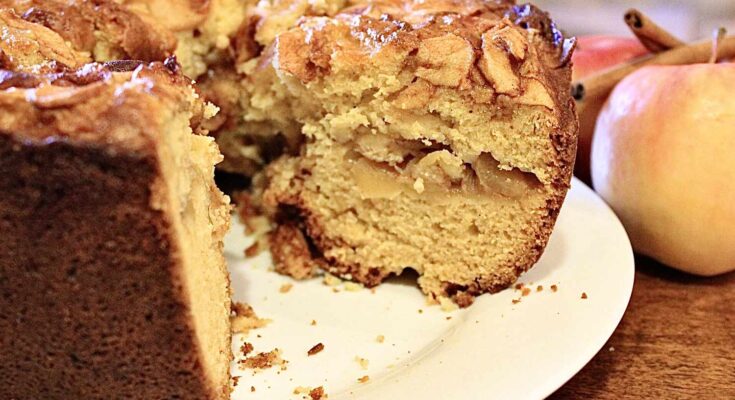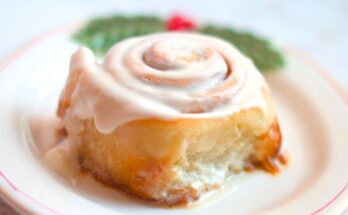Jewish Apple Cake Recipe: If you’ve ever walked into a kitchen filled with the warm aroma of cinnamon, baked apples, and vanilla, you’ll know exactly why Jewish Apple Cake holds a special place in so many homes. Unlike typical frosted cakes, this recipe is rustic yet elegant, deeply flavorful yet simple to make. What makes it unique is its origins—this cake has been passed down through generations in Jewish families, often baked for holidays and special occasions, particularly Rosh Hashanah when apples are a symbol of sweetness for the new year.
Unlike other apple-based cakes, Jewish Apple Cake is dairy-free. That’s right—no butter or milk here. Traditionally, this is because Jewish dietary laws (kashrut) forbid mixing dairy with meat, and since cakes were often served at meals where meat was present, the recipe was crafted to be completely dairy-free while still incredibly moist and rich. That little detail makes it perfect for those who are lactose-intolerant or prefer non-dairy desserts.
Another defining trait of this cake is the layering method. Instead of just folding apples into the batter, you’ll actually create alternating layers of cinnamon-sugar coated apples and rich cake batter. As the cake bakes, the apples soften, releasing their juices into the sponge while the top develops a golden crust with caramelized edges. The result? A cake that’s both dense and moist, bursting with apple flavor in every bite.
Think of it as a cross between a pound cake and a coffee cake, but with a personality all its own. Whether you’re baking it for a family gathering, gifting it to a neighbor, or simply enjoying it with your morning coffee, Jewish Apple Cake is the kind of recipe that quickly becomes a household favorite.
Ingredients You’ll Need
Before we dive into the step-by-step guide, let’s get our ingredients ready. Having everything measured and prepped will make the baking process smooth and stress-free.
Core Ingredients for the Cake Batter
- 3 cups all-purpose flour
- 2 cups granulated sugar
- 1 tablespoon baking powder
- ½ teaspoon salt
- 1 cup vegetable oil (neutral oils like canola or sunflower work best)
- 4 large eggs
- ¼ cup orange juice (freshly squeezed if possible)
- 2 teaspoons vanilla extract
These are the backbone of the cake. The oil provides moisture without heaviness, while orange juice adds a subtle brightness that balances the sweetness.
Fresh Apples – The Star of the Recipe
- 6 medium apples (Granny Smith, Honeycrisp, or Fuji work wonderfully)
- 2 teaspoons ground cinnamon
- 5 tablespoons granulated sugar (for coating the apples)
The apples bring the soul to this cake. Firm, tart varieties hold up best under baking, creating a perfect contrast with the sweet batter. Cinnamon and sugar coat each slice, ensuring flavor in every layer.
Spices and Flavor Boosters
- A pinch of nutmeg (optional)
- ½ cup chopped walnuts or pecans (optional, for crunch)
Nutmeg deepens the warmth of the cinnamon, while nuts give an extra layer of texture. Of course, you can skip them if you want to keep it nut-free.
With these ingredients in place, you’re all set to build a masterpiece. And now comes the fun part—bringing it all together!
Step-by-Step Guide to Making Jewish Apple Cake
Step 1 – Preparing the Apples
Peel, core, and slice your apples into thin wedges. Toss them in a little cinnamon and sugar to enhance their flavor and prevent browning. Set them aside while you prepare the batter.
Step 2 – Mixing the Dry Ingredients
In a large bowl, whisk together flour, baking powder, salt, and a touch more cinnamon. This creates the structure for your cake and ensures the dry ingredients are evenly distributed.
Step 3 – Creating the Wet Mixture
In a separate bowl, beat together eggs, sugar, vegetable oil, orange juice (a signature touch in Jewish apple cake), and vanilla extract. Mix until smooth and slightly frothy.
Step 4 – Combining Everything Together
Gradually add the dry ingredients into the wet mixture, stirring gently until just combined. Be careful not to overmix—the goal is a smooth batter without toughness.
Step 5 – Layering the Apples and Batter
Grease a tube pan or Bundt pan. Pour a layer of batter on the bottom, then add a layer of apples. Continue alternating layers of batter and apples until everything is used up, finishing with apples on top for a beautiful baked finish.
Step 6 – Baking to Perfection
Preheat your oven to 350°F (175°C). Bake the cake for about 60–75 minutes, or until a toothpick inserted into the center comes out clean. The apples should be tender and the cake golden brown.
Step 7 – Cooling and Serving
Let the cake cool in the pan for at least 15–20 minutes before carefully removing it. Once fully cooled, slice and serve plain or with a light dusting of powdered sugar.
Tips for the Perfect Jewish Apple Cake
Choosing the Right Apples
Not all apples are created equal when it comes to baking. You want a variety that holds its shape without turning mushy. Granny Smith is a top pick because of its tartness, which balances the sweetness of the cake. Honeycrisp and Fuji are also excellent, adding both crunch and flavor. Avoid Red Delicious—they tend to lose structure and become bland once baked.
Avoiding Common Baking Mistakes
- Overmixing: Remember, a gentle hand keeps the crumb tender.
- Skipping the layering: Don’t just dump apples into the batter; the magic lies in those alternating layers.
- Underbaking: Because this cake is dense, it takes longer than you might think. Always check with a toothpick in multiple spots.
Enhancing Flavor with Simple Tweaks
If you want to take your Jewish Apple Cake to the next level, consider these small adjustments:
- Add a pinch of cardamom for a more complex spice profile.
- Swap out half the oil with applesauce for a lighter version.
- Add raisins or cranberries to the apple layer for a tart-sweet surprise.
These little tricks can personalize the cake and make it uniquely yours, while still keeping it true to tradition.
Variations of Jewish Apple Cake
One of the beautiful things about Jewish Apple Cake is its adaptability. While the traditional recipe is beloved, you can easily tweak it to suit your taste or dietary needs without losing its essence.
Adding Nuts for Crunch
If you enjoy texture in your baked goods, nuts are a fantastic addition. Walnuts and pecans are the most common choices since their earthy flavor pairs beautifully with apples and cinnamon. Simply fold about half a cup of chopped nuts into your batter before layering. You can also sprinkle a few on top of the final apple layer for extra crunch. Just keep in mind that nuts can burn if too exposed, so a light sprinkle is best.
Glaze or Dusting Sugar Options
Traditionally, this cake is served plain or with a dusting of powdered sugar, but if you’re looking to dress it up, a glaze can make it shine—literally and figuratively. A simple glaze made of powdered sugar and orange juice or milk (if you’re not keeping it dairy-free) creates a glossy finish that complements the cake without overpowering it. For a more rustic approach, stick with powdered sugar and let the apple-cinnamon aroma take center stage.
Making It Dairy-Free
The best part? Jewish Apple Cake is already dairy-free! But if you want to make it even more allergen-friendly, you can substitute the eggs with flax eggs or a commercial egg replacer. You’ll still get a rich, moist cake that holds together beautifully. For those who are gluten-sensitive, swapping the all-purpose flour with a reliable 1:1 gluten-free baking mix works surprisingly well.
The variations are endless, and each one gives you a slightly different experience while keeping the soul of the cake intact.
How to Store and Preserve Jewish Apple Cake
A cake this good rarely lasts long, but if you want to save some for later (or bake ahead for a gathering), storage is key.
Short-Term Storage Tips
Jewish Apple Cake keeps beautifully at room temperature for up to 3 days. Store it in an airtight container or wrap it tightly in plastic wrap to prevent it from drying out. If your kitchen is warm or humid, it’s best to refrigerate it. Just note that refrigeration can make the cake slightly denser, so allow it to come to room temperature before serving for the best texture.
Freezing the Cake for Later
If you want to make the cake in advance, freezing is your best option. Once the cake has cooled completely, wrap it tightly in plastic wrap and then in aluminum foil for extra protection. Stored this way, it can last up to 3 months in the freezer. When you’re ready to enjoy it, thaw it overnight in the fridge and let it come to room temperature before serving. The flavors actually deepen a bit after freezing, making it just as delicious (if not better) the second time around.
This makes Jewish Apple Cake an excellent make-ahead dessert for holidays, parties, or gifting.
Nutritional Breakdown
While Jewish Apple Cake isn’t exactly diet food, it’s worth noting what you’re getting in each slice.
Calories and Portion Size
On average, a slice of Jewish Apple Cake (about 1/12 of a standard bundt pan) contains around 350–400 calories. Most of those calories come from the sugar and oil, though the apples do add some fiber and vitamins. It’s indulgent, but hey, dessert is meant to be enjoyed!
Healthier Alternatives
If you’d like a lighter version, there are a few easy swaps you can make:
- Replace half the oil with unsweetened applesauce.
- Cut the sugar by ¼ to ½ cup (the apples provide natural sweetness).
- Use whole wheat pastry flour instead of all-purpose for added fiber.
These tweaks won’t drastically change the flavor but will make the cake a bit friendlier for everyday indulgence.
Why You’ll Love This Cake
Beyond the irresistible flavor and texture, Jewish Apple Cake carries with it a sense of tradition and warmth. It’s not just a dessert—it’s a story baked into every layer.
Perfect for Holidays and Gatherings
This cake is often baked for Jewish holidays like Rosh Hashanah, when apples are eaten as a symbol of sweetness for the coming year. But its appeal goes far beyond religious traditions. It’s the kind of dessert that fits seamlessly into Thanksgiving tables, Sunday family dinners, or even as a thoughtful homemade gift.
A Cake That Tells a Story
Each bite reminds you of its heritage—a recipe born from necessity (being dairy-free for kosher meals) that grew into a timeless classic. Baking it today connects you to generations of families who gathered around their tables, sharing stories, laughter, and slices of apple cake. It’s not just about eating; it’s about creating memories.
If you’re looking for a dessert that’s easy to make, rich in history, and universally loved, Jewish Apple Cake is it.
FAQs about Jewish Apple Cake Recipe
1. Can I make this cake in advance?
Yes! Jewish Apple Cake actually tastes better the next day as the flavors meld. You can bake it a day ahead and store it at room temperature or in the fridge.
2. Which apples are best for Jewish Apple Cake?
Granny Smith, Honeycrisp, and Fuji are the best choices. They hold up well to baking and balance sweetness with tartness.
3. Can I make it gluten-free?
Absolutely! Use a good 1:1 gluten-free flour blend. The texture will be slightly different, but still delicious.
4. How long does it stay fresh?
At room temperature, it stays fresh for up to 3 days. Refrigerated, it lasts about 5 days, and frozen it can be stored for up to 3 months.
5. What makes this cake “Jewish”?
It’s traditionally dairy-free, adhering to kosher dietary rules that separate meat and dairy. Over time, it became a staple dessert in many Jewish households, especially around holidays.
Conclusion
Jewish Apple Cake is more than just a recipe—it’s comfort, tradition, and flavor wrapped into one golden-brown masterpiece. With its tender crumb, spiced apple layers, and dairy-free charm, it’s a dessert that feels both old-fashioned and timeless. Whether you’re baking it for a holiday, a family gathering, or simply to enjoy with your morning coffee, it’s a cake that never disappoints.
So, roll up your sleeves, grab some apples, and let your kitchen be filled with the warm, welcoming aroma of cinnamon and sugar. Once you take that first bite, you’ll understand why this cake has been cherished for generations.



